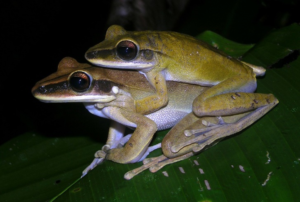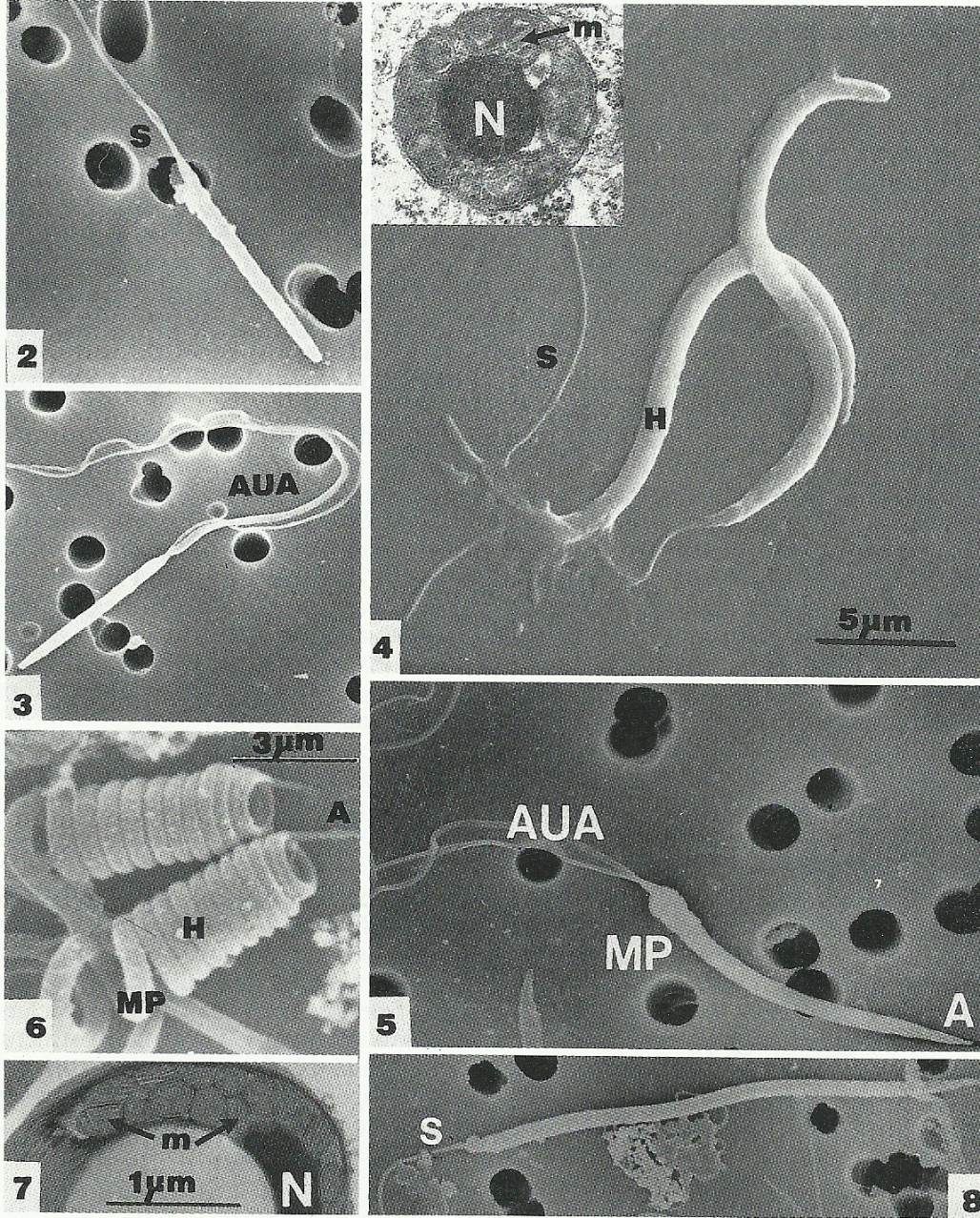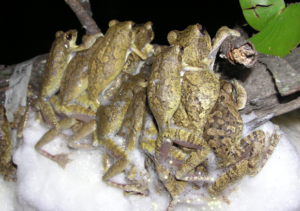Frogs are both sentinel and keystone species and globally threatened: The need to study their sperm biology!

Fig. 1: Amazon tree frog during amplexus. (https://live.staticflickr.com/2042/2432835781_af64b46f2f_b.jpg)
Everyone knows what a frog is but where do these fascinating animals fit in the Animal Kingdom? They are amphibians (can live on land – lungs and in water) and vertebrates (they all have a back bone, internal skeleton like fish, reptiles, birds and mammals). There are three Amphibian orders namely the frogs (Anura), salamanders (Urodeles) and legless amphibians (Gymnophiona). The frogs are by far the most diverse in size, habitat, reproduction and importance in nature. They are the only group of vertebrates that have a pseudo-copulation method called amplexus (male clasping female in front of hindlegs) and all three “fertilization modes” of external fertilization, intermediate and internal fertilization can take place (Fig. 1). They seem to occupy a position between external fertilization and internal fertilization. Accordingly, a study of their sperm relate to many interesting aspects such as sperm structure and motility in relation to fertilization environment.
Why are frogs important?
They can be partly and collectively called sentinel and keystone species. It means they are very sensitive to show signs that something is wrong in the ecosystem long before it is detected by humans and accordingly warn us of the potential dangers to human health (sentinel species). Furthermore, collectively frogs can be considered keystone species in their control of harmful insect species like mosquitos (some cause malaria). There is an alarming loss of many frog species due to human intervention, and this can affect aquatic and terrestrial food webs, nutrient cycling, algal biomass, and insect abundance. They accordingly have an extremely important ecological role to play. One of the focus areas relate to the wetlands where most frog species reside and are constantly threatened by new building development.
We have a responsibility to get involved in captive breeding of particularly frogs on the red list and in this context USA/Tanzania efforts (in Tanzania) and by the Johannesburg Zoo, South Africa, already contribute greatly. Ideally is to know the peak period for breeding, methods to obtain sperm, studies to understand sperm physiology and handling for purposes of artificial fertilization.

Fig. 2. Scanning electron microscopy of sperm of some South African frog species: Mainly frogs discussed in text will be referred to. 2.2 = Cape river frog; 2.4 = African clawed toad; 2.6 = Foam nest frog; 2.8 = Cape rain frog (van der Horst, Wilson and Channing, 1995)
The immense diversity of sperm form/structure is spectacular and amazing in frogs (Fig. 2). Sperm can be very simple like in Cape river frogs where the sperm head is cigar shaped and a very simple tail (Fig. 2.2) compared to the great complexity of the foam nest frog (tree frog) with a highly coiled head that can unfold like a spring during fertilization (Fig. 2.6). We have shown in the UWC comparative sperm laboratory that sperm form and swimming behaviour largely relates to the mode of fertilization. For example, in the foam nest frog (heavily coiled head) the female positions on a tree branch overhanging water and secretes from her cloaca a white fluid. She starts beating it up with her hind legs to form a huge foam ball (almost like egg white). Six to seven males then join her and while she lays eggs in the foam the males either go in amplexus and/or ejaculate sperm in the foam and over the eggs (Fig. 3). Fertilization occur and the tadpoles developed in the foam nest that now hardens. Once the tadpoles are well developed inside they release an enzyme that breaks the hardened foam and fall into the water below and start swimming and feeding and get transformed into a frog eventually.

Fig. 3: Foam nest frogs having a “sex orgy” in a foam nest created by female. (https://www.australiangeographic.com.au/news/2011/02/harmonious-orgy-is-winning-formula-for-frogs/. Amazing photography by Martin Whiting).
Sperm of frogs that are not released in water like the foam nest frog (Fig. 2.6) and the Cape Rain frog (Fig. 2.8) have very long sperm heads of over 20 µm in length and show either no motility or very poor sperm swimming ability compared to the toad, Bufo, with shorter sperm heads (Fig. 2.5) which swims fast for frogs and about the same speed as human sperm as analysed by CASA. Accordingly, frog sperm seem to swim very slowly compared to most other vertebrates (fish, reptiles, birds and mammals). One of the main reasons for this appears to be the deposition of eggs very close to male cloaca and almost direct ejaculation on eggs. So there appears to be less need for fast swimming sperm.
Sperm motility in frogs can be studied by means of SCA CASA and have many applications both in terms of artificial fertilization and sperm competition and assessing motility after cryo-protection. Nigrosin – eosin based stain such as BrightVit also distinguishes well between live and dead sperm.
LET’S DO FROG SPERM AS IT IS IMPORTANT FOR THEIR AND OUR SURVIVAL!!!
References
Van der Horst, G, Wilson, B and Channing, A. (1995). Amphibian sperm: Phylogeny and Fertilization Environment. In Jameson, Ausio and Justine (eds) Advances in spermatozoal phylogeny and taxonomy. Mem. Mus natn. Hist nat 16X:332-342. Paris ISBN: 2-85653-225-X
Byrne, PG and Whiting, MJ (2011). Effects of simultaneous polyandry on offspring fitness in an African tree frog. Beavioural Ecology 22: 385 – 391 https://doi.org/10.1093/beheco/arq15
Prof Gerhard van der Horst (PhD, PhD)
Senior Consultant
MICROPTIC S.L.




Leave A Comment